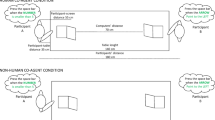Abstract
There is much recent interest in the idea that we represent our knowledge together with the sensory and motor features that were activated during its acquisition. This paper reviews the evidence for such “embodiment” in the domain of numerical cognition, a traditional stronghold of abstract theories of knowledge representation. The focus is on spatial-numerical associations, such as the SNARC effect (small numbers are associated with left space, larger numbers with right space). Using empirical evidence from behavioral research, I first describe sensory and motor biases induced by SNARC, thus identifying numbers as embodied concepts. Next, I propose a hierarchical relationship between grounded, embodied, and situated aspects of number knowledge. This hierarchical conceptualization helps to understand the variety of SNARC-related findings and yields testable predictions about numerical cognition. I report several such tests, ranging from cross-cultural comparisons of horizontal and vertical SNARC effects (Shaki and Fischer in J Exp Psychol Hum Percept Perform 38(3):804–809, 2012) to motor cortical activation studies in adults with left- and right-hand counting preferences (Tschentscher et al. in NeuroImage 59:3139–3148, 2012). It is concluded that the diagnostic features for each level of the proposed hierarchical knowledge representation, together with the spatial associations of numbers, make the domain of numerical knowledge an ideal testing ground for embodied cognition research.
Similar content being viewed by others
References
Andres M, Davare M, Pesenti M, Olivier E, Seron X (2004) Number magnitude and grip aperture interaction. NeuroReport 15:2773–2777
Barsalou LW (2008) Grounded cognition. Annu Rev Psychol 59:617–645
Berch DB, Foley EJ, Hill RJ, Ryan PM (1999) Extracting parity and magnitude from Arabic numerals: developmental changes in number processing and mental representation. J Exp Child Psychol 74:286–308
Bermudez JL (2010) Cognitive science. An introduction to the science of the mind. Cambridge University Press, Cambridge
Casasanto D (2011) Different bodies, different minds: the body specificity of language and thought. Curr Dir Psychol Sci 20(6):378–383
Dehaene S, Bossini S, Giraux P (1993) The mental representation of parity and number magnitude. J Exp Psychol Gen 122:371–396
Dijkstra K, Kaschak MP, Zwaan RA (2008) Body posture facilitates retrieval of autobiographical memories. Cognition 102:139–149
Domahs F, Moeller K, Huber S, Willmes K, Nuerk H-C (2010) Embodied numerosity: implicit hand-based representations influence symbolic number processing across cultures. Cognition 116:251–266
Fischer MH (2003) Spatial representations in number processing—evidence from a pointing task. Visual Cogn 10(4):493–508
Fischer MH, Brugger P (2011) When digits help digits: spatial-numerical associations point to finger counting as prime example of embodied cognition. Front Psychol 2:260. doi:10.3389/fpsyg.2011.00260
Fischer MH, Castel AD, Dodd MD, Pratt J (2003) Perceiving numbers causes spatial shifts of attention. Nat Neurosci 6(6):555–556
Fischer MH, Mills RA, Shaki S (2010) How to cook a SNARC: number placement in text rapidly changes spatial-numerical associations. Brain Cogn 72:333–336
Glenberg AM, Kaschak MP (2002) Grounding language in action. Psychon Bull Rev 9:558–565
Harnad S (1990) The symbol grounding problem. Physica D 42:335–346
Hauk O, Johnsrude I, Pulvermüller F (2004) Somatotopic representation of action words in human motor and premotor cortex. Neuron 41:301–307
Ito Y, Hatta T (2004) Spatial structure of quantitative representation of numbers: evidence from the SNARC effect. Mem Cognit 32:662–673
Keehner M, and Fischer MH (2012) Unusual bodies, uncommon behaviors: embodied cognition and individual differences in spatial tasks. Special Issue of Spatial Cognition and Computation, 12 (2–3)
Lakoff G, Johnson M (1999) Philosophy in the flesh. Basic Books, New York
Lindemann O, Alipour A, Fischer MH (2011) Finger counting habits in Middle-Eastern and Western individuals: an online survey. J Cross Cult Psychol 42:566–578
Loetscher T, Schwarz U, Schubiger M, Brugger P (2008) Head turns bias the brain’s random number generator. Curr Biol 18(2):R60–R62
Schwarz W, Keus I (2004) Moving the eyes along the mental number line: comparing SNARC effects with manual and saccadic responses. Percept Psychophys 66:651–664
Shaki S, Fischer MH (2012) Multiple spatial mappings in numerical cognition. J Exp Psychol Hum Percept Perform 38(3):804–809
Shepard RN, Metzler J (1971) Mental rotation of three-dimensional objects. Science 171:701–703
Tschentscher N, Hauk O, Fischer MH, Pulvermüller F (2012) You can count on the motor cortex: fMRI reveals embodied number processing. NeuroImage 59:3139–3148
Umilta MA, Escola L, Intskirveli I, Grammont F, Rochat M, Caruana F, Jezzini A, Gallese V, Rizzolatti G (2008) When pliers become fingers in the monkey motor system. Proc Nat Acad Sci USA 105(6):2209–2213
Wood G, Nuerk HC, Willmes K, Fischer MH (2008) On the cognitive link between space and number: a meta-analysis of the SNARC effect. Psychol Sci Q 50(4):489–525
Zebian S (2005) Linkages between number concepts, spatial thinking, and directionality of writing: the SNARC effect and the reverse SNARC effect in English and Arabic monoliterates, biliterates, and illiterate Arabic speakers. J Cogn Cult 5:166–190
Conflict of interest
This supplement was not sponsored by outside commercial interests. It was funded entirely by ECONA, Via dei Marsi, 78, 00185 Roma, Italy.
Author information
Authors and Affiliations
Corresponding author
Rights and permissions
About this article
Cite this article
Fischer, M.H. A hierarchical view of grounded, embodied, and situated numerical cognition. Cogn Process 13 (Suppl 1), 161–164 (2012). https://doi.org/10.1007/s10339-012-0477-5
Published:
Issue Date:
DOI: https://doi.org/10.1007/s10339-012-0477-5




